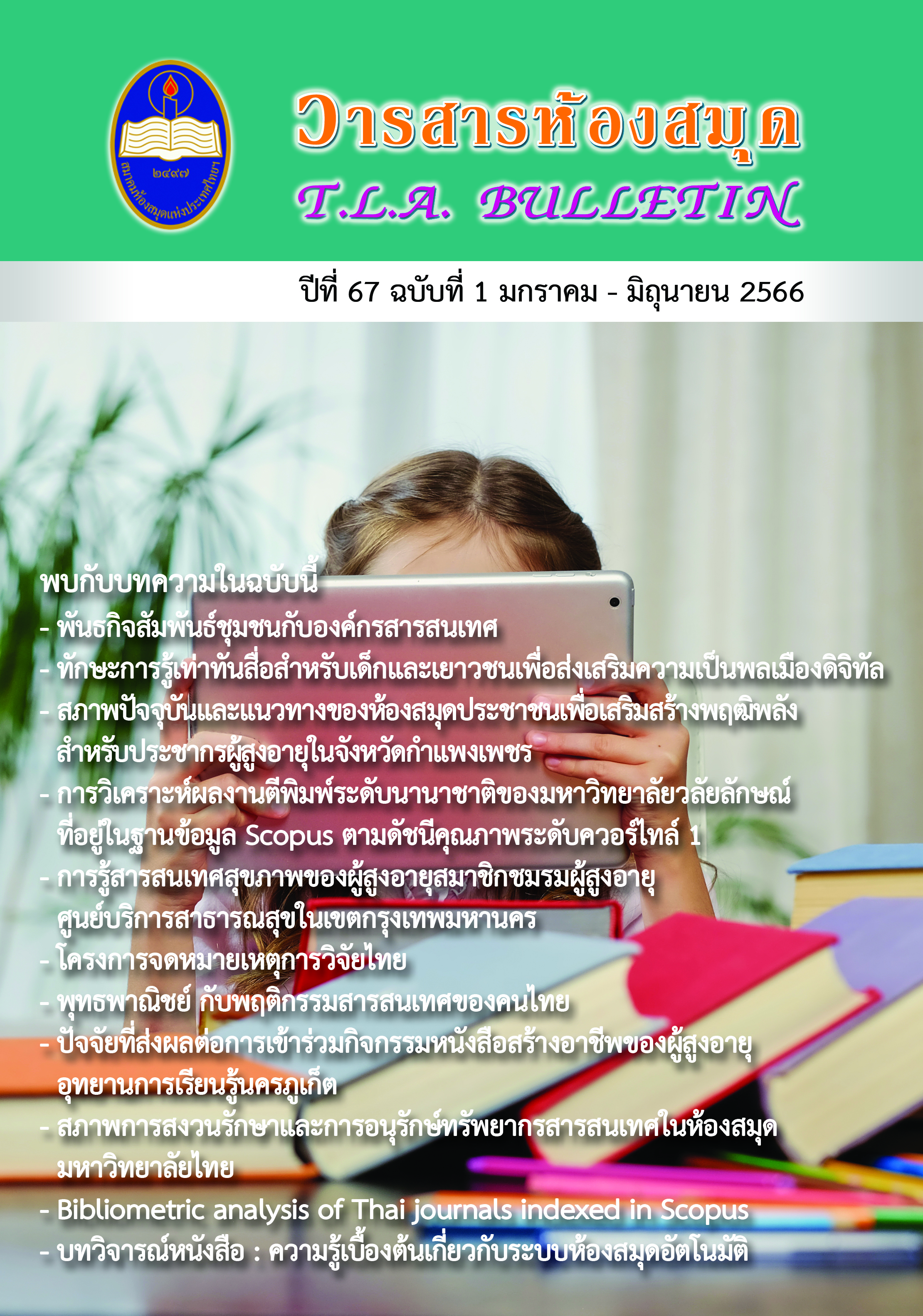การวิเคราะห์บรรณมิติของวารสารไทยในฐานข้อมูล Scopus
คำสำคัญ:
การวิเคราะห์บรรณมิติ, ฐานข้อมูล Scopus, Scimago Journal & Country Rank (SJR), การสร้างแผนภาพบทคัดย่อ
การศึกษาชิ้นนี้มีวัตถุประสงค์เพื่อ 1) วิเคราะห์สถิติการดำเนินงานของวารสารวิชาการสาขาวิทยาศาสตร์อันดับ 1-20 ที่ตีพิมพ์โดยองค์กรในประเทศไทย จากการจัดอันดับของ SJR ตั้งแต่ปี ค.ศ. 1999- 2021 และ 2) วิเคราะห์บรรณมิติของวารสารสาขาวิทยาศาสตร์ที่มีคะแนน SJR สูงจำนวน 1 วารสาร โดยรวบรวมข้อมูลเชิงปริมาณ ข้อมูลที่ใช้ประกอบด้วย จำนวนการถูกอ้างอิง จำนวนบทความที่ตีพิมพ์ในแต่ละปี และความร่วมมือระหว่างประเทศ ศึกษาวิจัยโดยวิธีวิเคราะห์เชิงปริมาณโดยใช้เครื่องมือ เส้นเวลา และเครื่องมือทางสถิติเบื้องต้น เพื่อหาค่าร้อยละ ค่าเฉลี่ย ส่วนเบี่ยงเบนมาตรฐาน สหสัมพันธแบบเพียรสันเพื่อหาความสัมพันธ์ระหว่าง SJR และค่าการถูกอ้างอิง
ผลการศึกษาพบว่า 1) วารสารวิชาการสาขาวิทยาศาสตร์ 20 อันดับแรกของประเทศไทยประกอบด้วยวารสารในสาขาวิทยาศาสตร์สิ่งแวดล้อม วิศวกรรมศาสตร์ วิทยาศาสตร์การเกษตรและวิทยาศาสตร์ชีวภาพเป็นส่วนใหญ่ และวารสารในกลุ่มนี้โดยส่วนมากถูกบรรจุเข้าสู่ฐานข้อมูล Scopus หลังจากปี พ.ศ. 2553 2) บรรณมิติของวารสารอันดับที่ 1 ของสาขาวิทยาศาสตร์ Asian Pacific Journal of Allergy and Immunology พบว่า วารสารมีจำนวนการตีพิมพ์โดยเฉลี่ยปีละ 40 บทความ มีจำนวนการอ้างอิงมากกว่าบทความที่ตีพิมพ์ในทุกๆปี ส่วนการศึกษาความหลายหลายของผู้นิพนธ์บทความของวารสารตั้งแต่ปี 2016-2021 พบว่า ผู้นิพนธ์ส่วนมากอยู่ในภูมิภาคเอเชีย และมีความร่วมมือระหว่างประเทศโดยเฉลี่ยอยู่ที่ร้อยละ 11
Downloads
เอกสารอ้างอิง
Alizade, H. (2014). Performance analysis of ISC journals using Scopus and ISC indicators. International
Journal of Information Science and Management, Special Issue, 39-44.
Apinya, I. (2019). Guidelines for searching and interpreting environmental sciences journal metrics data at national and international levels. KMUTT Research & Development Journal, 42(1), 3-22.
Chinchilla-Rodriguez, Z., Arencibia-Jorge, R., Moya-Anegon, F. & Corera-Alvarez, E. (2015). Somes patterns of Cuban scientific publication in Scopus: the current situation and challenges. Scientometrics, 103,779–794.
Davidson. (1969). The Periodicals Collection: Its Purpose and Uses in Libraries. London: Andro Doutsch.
Elsevier.(2023). SRCTITLE (asian AND pacific AND journal AND of AND allergy AND immunology). Retrieved January 10, 2023, from https://www.scopus.com/results/ results.uri?cc=10&sort=cp-f&src=s&st1=Asian+Pacific+Journal+of+Allergy+and+Immunology&nlo=&nlr=&nls=&sid=2c7b6f025a915b70303e66e606feaaae& sot=b&sdt=b&sl=57&s=SRCTITLE%28Asian+Pacific+Journal+of+Allergy +and+Immunology%29&ss=cp-f&ps=r-f&editSaveSearch=&origin =resultslist&zone=resultslist.
Elsevier.(2022a). Content policy and selection. Retrieved November 8, 2022, from https://www.elsevier.com/solutions/scopus/how-Scopus-works/content/content-policy-and-selection.
Elsevier. (2022b). What is a corresponding author?. Retrieved November 8, 2022 from https://scientific-publishing.webshop.elsevier.com/ publication-recognition/what- corresponding-author/.
Erfanmanesh, M., Tahira, M. & Abrizah. (2017). The publication success of 102 nations in Scopus and the performance of their Scopus-Indexed Journals. Pub Res Q, 33, 421-432.
Jan, N. & Ludo, V. E. (2009). Software survey: VOSviewer, a computer program for bibliometric mapping Conf. Scientometric. Informetrics, 84, 523–538.
Jang, H. (2020). Analysis of Korean journals rejected by Scopus since 2011. Science Editing, 7(1), 50-54.
Kipper, L., Furstenau, L., Hoppe, D. Frozza, R. & Iespen, S. (2019). Scopus scientific mapping production in industry 4.0 (2011–2018): a bibliometric analysis. International Journal of Production Research, 2019, 1-23.
Krauskopf, E. (2018). An analysis of discontinued journals by Scopus. Scientometrics, 116, 1805–1815.
Lin, X. (2018). Timeline Analysis. In: Introductory Computer Forensics. Springer, Cham. https://doi.org/10.1007/978-3-030-00581-8_12.
Lukman, L., Rianto, Y., Al Hakim, S. Nadhiroh, I. & Hidayat, D. (2018). Citation performance of Indonesian scholarly journals indexed in Scopus from Scopus and Google Scholar. Science Editing, 5(1), 53-58.
Malvić, T., Andreic, Z., Barudžija, U., Bedekovic, G., Hrncevic, L., Ivšinovic, J., Korman, T., Kovac, Z., Pavlic, K., & Pašic, B. (2022). Citation rate challenges for a small journal indexed in scopus and WoS— case study from central europe (Croatia), editorial view. Publications,10(3), 1-18.
Moed, H., Moya-Anegonb, F., Guerrero-Botec, V. & Lopez-Illescas, C. (2020). Are nationally oriented Journals indexed in Scopus becoming more international? The effect of publication language and access modality. Journal of Informetrics, 14, 1-10.
Nakornthap, P. (2016). An analysis of research papers indexed in Scopus and Web of Science which authored by faculty staff of the Petroleum and Petrochemical College, Chulalongkorn University. TLA Research Journal, 9(1), 23-44. [In Thai]
Okagbue, H., Atayero, A. Adamu, M., Bishop, S., Oguntunde, P. & Opanuga, A. (2018). Exploration of editorial board composition, Citescore and percentiles of Hindawi journals indexed in Scopus. Data in Brief, 19, 743-752.
Rodgers, J. & Nicewander, W. (1988). Thirteen ways to look at the correlation coefficient. The American Statistician, 42(1), 59-66.
Rogers, G., Szomszor, M. & Adams, J. (2020). Sample size in bibliometric analysis. Scientometrics,125,777-794.
SCImago (2022a). Ranking methodology. Retrieved November 8, 2022, from https://www.scimagoir.com/methodology.php.
SCImago. (2022b). SJR - SCImago Journal & Country Rank [Portal]. Retrieved November 8, 2022 from http://www.scimagojr.com.
Scimago Lab. (2022). Scimago Journal & County Rank. Retrieved November 8 from https://www.scimagojr.com/journalrank.php? country=TH
Sirirak, K. (2021). Analysis of Walailak Journal of Science and Technology indexed in Scopus database between 2012-2020: A bibliometric analysis. TLA Bulletin, 65(2), 137-154. [In Thai]
Srisawad, S. (2019). The association of research collaboration and bibliometrics data with citation impact among articles based on Scopus Q1 from Nursing Institutions in Thailand. Princess of Naradhiwas University Journal of Humanities and Social Sciences, 6(1), 154-170. [In Thai]
Taterian, C., & Damrongson, T. (2017). Development Thai journal by Google Scholar. PULINET Journal, 4(2), 237-246. [In Thai]
Thai-Journal Citation Index Centre. (2022a). Evaluation results of journal quality in the TCI database. Retrieved November 8, 2022 from https://tci-thailand.org/p/3796/. [In Thai]
Thai Journal Citation Index Centre.(2022b). List of journals in TCI-TSRI-Scopus Collaboration Project Phase2. Retrieved November 8, 2022 from https://tci-thailand.org/list-of-journals-in-tci-tsri-scopus-collaboration-project-phase2-2/. [In Thai]
THE Times Higher Education. (2022). World University Rankings 2022: methodology. Retrieved November 8, 2022 from https://www.timeshighereducation.com/world-university-rankings/world-university-rankings-2022-methodology.
Van Eck, N. J. & Waltman, L. (2010). Software Survey: VOSviewer, a Computer Program for Bibliometric Mapping. Scientometrics, 84(2), 523–38.
Wang, X., Xu, Z. & Skare, M. (2020). A bibliometric analysis of Economic Research-Ekonomska
Istrazivanja (2007–2019). Economic Research-ekonomska Istraživanja, 33(1), 865-886.
ดาวน์โหลด
เผยแพร่แล้ว
รูปแบบการอ้างอิง
ฉบับ
ประเภทบทความ
สัญญาอนุญาต
ลิขสิทธิ์ (c) 2023 วารสารห้องสมุด สมาคมห้องสมุดแห่งประเทศไทยฯ

อนุญาตภายใต้เงื่อนไข Creative Commons Attribution-NonCommercial-NoDerivatives 4.0 International License.




